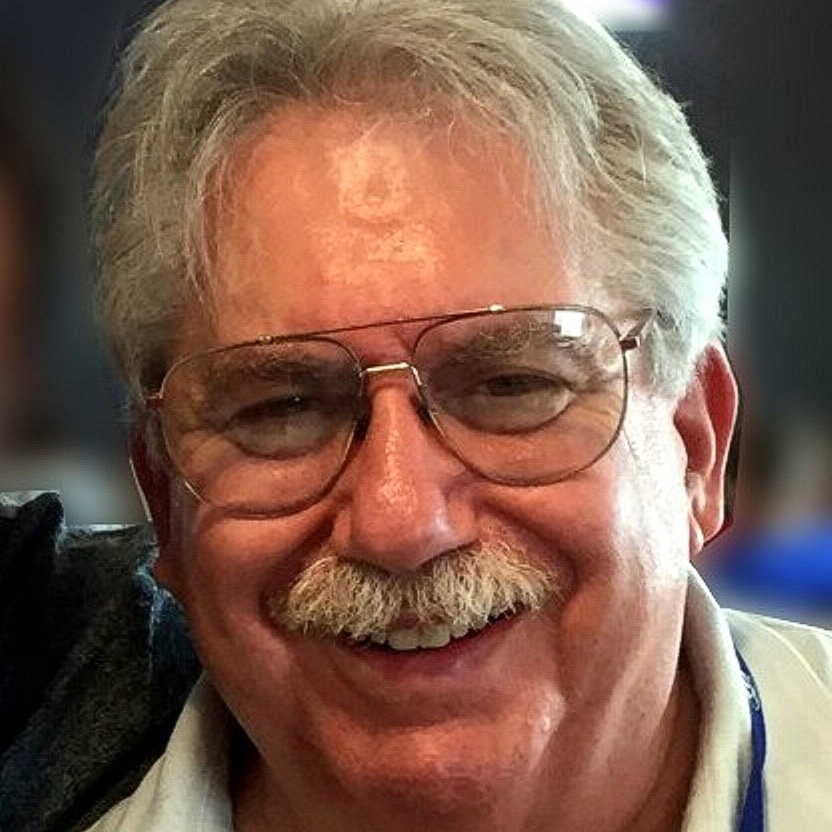I’ve had wonderful luck with piston aircraft engines throughout my nearly 50 years as an aircraft owner. All the engines on my airplanes have made TBO with minimal maintenance along the way, and in recent years they’ve gone far, far beyond TBO.
For decades, I was convinced that the secret of my success was the fact that I “babied” my engines, typically limiting my cruise power settings to no more than 60 or 65 percent power. I felt that sacrificing a little airspeed in exchange for long engine life and reduced maintenance cost was a good tradeoff.
I’ve come to learn, however, that such “babying” is one way to achieve long engine life, but it’s not the only way. That’s because it’s not POWER that damages out engines—it’s TEMPERATURE. It turns out you can run these engines as hard as you like so long as you are obsessive about keeping temperatures under control.
Or as my late friend, powerplant guru and former Continental Motors tech rep Bob “Mose” Moseley used to say, “There are three things that affect how long your engine will last: (1) temperature, (2) temperature, and (3) temperature!”
It’s all about the heat
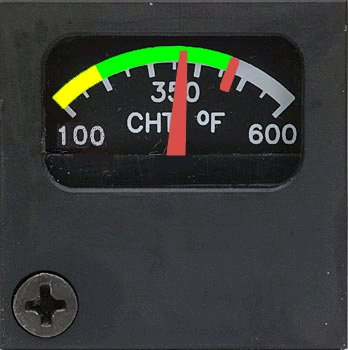
Our piston aircraft engines are heat engines. They have moving parts—notably exhaust valves and valve guides—that are continually exposed to extremely high temperatures in the vicinity of 1,500°F and sometimes hotter. Since engine oil cannot survive temperatures above about 400°F, these moving parts must function with no lubrication. They depend on extremely hard metals operating at extremely close tolerances at extremely high temperatures with no lubrication. Aluminum pistons and cylinder heads are also exposed to these very hot temperatures, despite the fact that aluminum melts at about 1,200°F. It’s nothing short of miraculous, and a testament to outstanding engineering, that these “hot section” components last as long as they do.
The key to making these critical parts last is temperature control, and the most important temperature is cylinder head temperature (CHT). Mose monitored and overhauled these engines for nearly four decades, and he swore to me that an engine that is operated at CHTs above 400°F on a regular basis will show up to five times as much wear metal in oil analysis as an identical engine that is consistently limited to CHTs of 350°F or less. “It’s amazing how much a small increase in CHT can accelerate engine wear,” Mose said.
As critical as CHT is, many owners don’t have a clue whether their CHTs are 400°F+ or 350°F-. That’s because the engine instrumentation provided by most aircraft manufacturers is pathetically inadequate. The typical factory CHT gauge looks at only one cylinder, and it’s not necessarily the hottest one. Further, the typical factory CHT gauge often isn’t even calibrated, and its green arc extends up to a ridiculously hot 460°F (for Continentals) or 500°F (for Lycomings). Those numbers may be okay as emergency red lines, but they’re horribly abusive for continuous operation. If all you have is factory gauges, you could easily be cooking your cylinders to death while blissfully thinking that all is okay because the CHT gauge is well within the green arc.
To know what’s really going on in front of the firewall, you have to have a modern multiprobe engine analyzer with a digital readout. Such instrumentation isn’t cheap—figure $2,500 for a single or $5,000 for a twin, installed—but if it saves you from having to replace a couple of jugs en route to TBO, it has more than paid for itself. Installing a digital engine analyzer is probably the best money you can spend on your airplane.
Fuel system setup
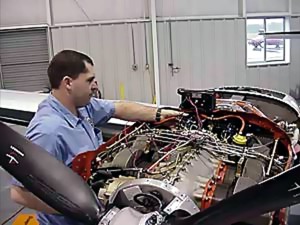
For takeoff and initial climb, we normally are at wide-open throttle, full-rich mixture, maximum RPM (if we have a constant-speed prop), and wide-open cowl flaps (if we have those). So there’s not much we can do from the cockpit to affect CHT during these phases of flight.
What does affect CHT is how our full-power fuel flows are adjusted. Unfortunately, it is shockingly common to see damagingly high CHTs due to improperly adjusted fuel flows, particularly in fuel-injected engines. It is not unusual for the fuel flows to be set wrong from the day an engine is installed, and never to be checked or adjusted all the way to TBO. The owner winds up going through cylinders every 500 hours and never knowing why (or blaming the manufacturer).
In part, the problem lies with mechanics who don’t fully understand how critical it is to test and adjust the fuel system setup on a regular basis. Continental recommends that the fuel system setup on its fuel-injected engines be checked and adjusted several times a year to account for seasonal changes. I’ll grant that’s a bit anal, but most Continental-powered airplanes go year after year without this ever being done, and many shops that maintain these airplanes don’t even have the necessary test equipment to do it.
Even when mechanics do test and adjust the fuel system, they often adjust it wrong. For example, Continental Manual M-0 (formerly SID97-3G) contains a lengthy table that specifies full-power fuel flow as a range (minimum and maximum). The “fine print” instructs mechanics to adjust the full-power fuel flow to the high end of the specified range, but many mechanics miss this subtlety and adjust it to the middle of the range. Experience shows that this is simply not enough fuel flow to keep CHTs cool during hot-weather takeoffs.
Lycoming engines with RSA fuel injection have no field adjustments for takeoff fuel flow. If it’s inadequate, the fuel servo has to be sent in to a specialty shop for bench checking and adjustment.
Then there’s the problem of aftermarket engine modifications. For example, engines that have been retrofitted with Superior’s Millennium cylinders often run higher CHTs than they did with their original factory cylinders. That’s because Millennium cylinders have substantially better “volumetric efficiency” than factory cylinders—in other words, they breathe better. Since they breathe more air during every combustion cycle, they need more fuel to maintain the same fuel/air mixture. The full-power fuel flow marked on your fuel-flow gauge may simply not be high enough if you have Millennium cylinders installed.
Even worse are turbocharged engines with aftermarket intercoolers installed. The intercooler reduces the temperature of the air that the cylinder breathes, making it denser. Denser air demands more fuel to maintain the desired fuel/air mixture, so full-power fuel flow must be increased significantly above original factory specifications. Too often this is not done, and the result is fried cylinders.
Many A&Ps are reluctant to adjust takeoff fuel flow above red-line. However, if you have Millennium cylinders, an aftermarket intercooler, or some other “mod” that allows your engine to produce more power than it did when it left the factory, that’s exactly what must be done to keep your CHTs cool and avoid premature cylinder failure.
Enough fuel flow?
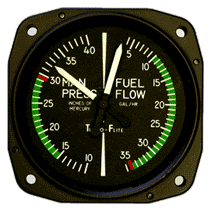
How can you tell if your full-power fuel flow is adequate? If you’re limited to factory gauges, you probably can’t, at least with any precision. About the best you can to is to watch your fuel flow gauge (if you have one).
A good rule of thumb is to multiply your engine’s maximum rated horsepower by 0.1 to obtain the minimum required fuel flow in gallons-per-hour, or by 0.6 for pounds-per-hour. For example, if your engine is rated at 285 horsepower, your takeoff fuel flow should be at least 28.5 GPH; if it’s rated 310 horsepower, the minimum should be 31.0 GPH. If your takeoff fuel flow is significantly less than this, have your mechanic crank it up. And don’t forget that if you have Millennium cylinders or an aftermarket intercooler, your engine might be producing a few percent more horsepower than what the book says, so it might need a few percent more fuel flow.
Now if you have a digital multiprobe engine analyzer, it’s easy to tell if your fuel flow is adjusted high enough. Just make sure none of your CHTs exceed 380°F during takeoff and climb for Continentals or 400°F for Lycomings. Lower is even better.
What about cruise?
Cruise flight represents the lion’s share of our flying time. Just as in takeoff and climb, it’s essential to keep all our CHTs at or below 380°F (for Continentals) or 400°F for Lycomings during cruise to achieve good cylinder longevity, and lower is even better. There are basically three different strategies for keeping CHTs low during cruise:
- Baby the engine
- Operate very rich
- Operate lean-of-peak
All three strategies work, and conscientious use of any of them will give you a good shot at making TBO with minimum cylinder problems. But each has its pros and cons. Let’s take a closer look.
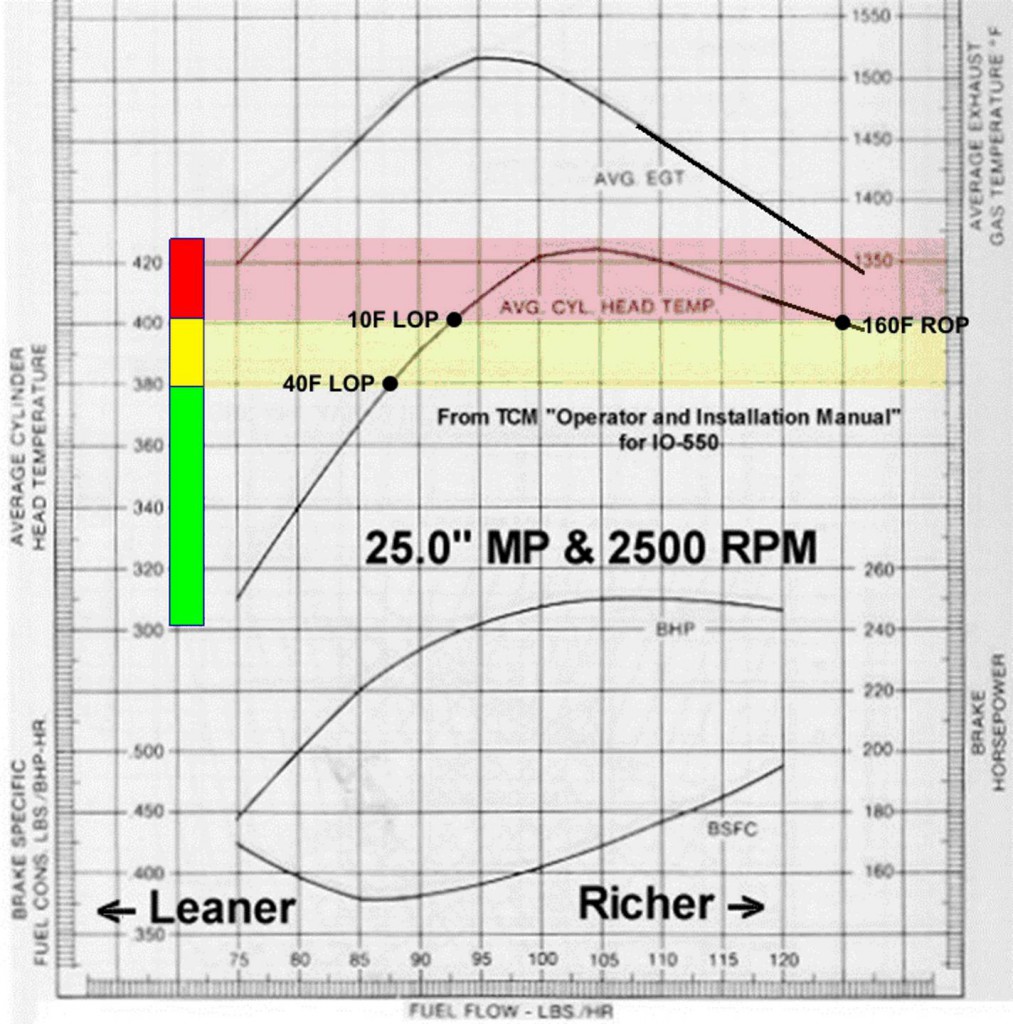
Baby the engine
Many POHs talk about operating at three alternative mixture settings: “best power mixture” (~125°F rich-of-peak), “recommended lean mixture” (~50°F rich of peak, and “best economy mixture” (~peak EGT). It turns out that “recommended lean mixture” (~50°F ROP) is just about the worst possible mixture setting for keeping CHT low. If you look at Figure 1, you’ll see that CHT reaches a maximum very close to 50°F ROP. So if you want to operate at “recommended lean mixture” and simultaneously keep CHT low, there’s only one way to get there: reduce power dramatically (generally 65% power or less). In other words, baby the engine.
Both “best power mixture” (~125°F ROP) and “best economy mixture” (~peak EGT) result in somewhat lower CHTs than does “recommended lean mixture.” At either of these mixture settings, you can usually operate at 70% power or so and still keep CHTs in the acceptable range.
In any of these cases, you’re trading power and airspeed for reduced temperatures and increased longevity. For most of us, that’s a reasonable tradeoff to make.
Operate very rich
But what if you are unwilling to sacrifice power and airspeed? Is it possible to go fast and still keep CHTs low?
Sure it is. We already talked about one way to do this in our discussion of takeoff and initial climb: pour lots of 100LL on the problem. In other words, operate very rich.
How rich? Figure 1 suggests that to reduce CHTs by 25°F, you need to enrich the mixture to about 160°F ROP. For each additional 10°F of CHT reduction, you need to enrich an additional 50°F ROP. Using such very rich mixtures, you can go fast and still stay cool. (This is how Reno racers usually operate.) But before you decide to go this route, consider the downsides.
The most obvious downside is that this strategy is very fuel-inefficient. Compared to “best economy mixture,” the very-rich strategy consumes about 25% more fuel, and reduces range by a similar amount. Advocates of very rich mixtures will tell you that “fuel is cheaper than engines,” but don’t be so sure. At today’s avgas prices, using 25% more fuel in a 300 horsepower engine can cost more than $40,000 over the engine’s TBO, and that’s enough to change out quite a few cylinders.
A second and less obvious downside is that very rich mixtures result in “dirty” combustion with lots of unburned byproducts in the exhaust gas. Operating this way for long periods of time tends to cause deposit buildup on piston crowns, ring grooves, spark plugs and exhaust valve stems. Do it long enough and you could wind up with stuck rings, stuck valves, worn valve guides, and fouled plugs.
Operate lean-of-peak
The third way to reduce CHTs is to lean even more aggressively than the POH recommends and operate on the lean side of peak EGT. Figure 1 shows that you can reduce CHTs by 25°F by leaning to about 10°F LOP. For each additional 10°F of CHT reduction, you need to lean an additional 15°F LOP. Using these very lean mixtures, you can go fast, stay cool, and obtain outstanding fuel economy, all at the same time.
What’s the downside of the LOP approach? The only major downside is that if your engine has uneven mixture distribution among its cylinders, it will usually run unacceptably rough at LOP mixture settings.
Uneven mixture distribution can usually be corrected in fuel-injected engines by “tuning” the fuel injector nozzles to eliminate the mixture imbalances. GAMIjectors are tuned nozzles that are STC’d for the majority of fuel-injected Continentals and Lycomings. Continental now offers its own version of tuned injectors on some of its premium engines.
If your engine is carbureted, you have no injector nozzles to tweak. Most carbureted Lycomings have pretty decent mixture distribution and can be run at least mildly LOP without running rough. Some carbureted Continentals (notably the O-470 used in the Cessna 182) have miserable mixture distribution, making it difficult to run those engines LOP without uncomfortable roughness.
Stay cool!
Whatever strategy you prefer, the important thing is to keep a close watch on your CHTs and ensure that they remain cool. The best way to do this is to install a multiprobe digital engine monitor and program its CHT alarm to go off at 390°F (Continentals) or 410°F (Lycomings). If the alarm goes off during takeoff or initial climb, you’re going to have to get your mechanic to turn up the full-power fuel flow. If it goes off during cruise, either enrich (if ROP) or lean (if LOP) to bring the CHT down to acceptable levels.
If you don’t have a multiprobe digital engine monitor, install one. The cost of such instrumentation (including installation) is usually less than the cost of replacing one cylinder. Failure to install such instrumentation is a classic case of “penny wise, pound foolish.”
